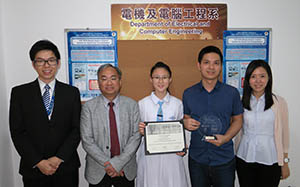A team from the University of Macau (UM) recently won the championship at the IEEE Mega-Challenge 2017: Smart Cities Competition, which was part of the IEEE RFID 2017 Conference, for their project ‘UHF RFID Based Gesture Control System for Smart City Transportation’. The system uses radio frequency identification to help visually impaired people communicate with the bus station via simple gesture control.
The competition was organised by the IEEE Council on Radio Frequency Identification, the largest academic institution on radio frequency identification. The theme of the competition was applications and innovations of RFID techniques in smart cities. The competition recruited proposals and contestants from all over the world. Four teams were selected to advance to the final held in Phoenix, United States. The system developed by the UM team uses radio frequency identification to help visually impaired people communicate with the bus station via simple gesture control. Led by Prof Tam Kam-Weng and Dr Lao Keng-Weng from the Department of Electrical and Computer Engineering, the UM team consisted of Zhang Wenhai, a doctoral student from the same department; and Lou Wan-Ian, a student from Scared Heart Canossian College (English Section) who received training in the department.
The proposal is the first one in the world that analyses the relationship between the energy absorption of an antenna and the passive RFID tags. It proposes the nonlinear energy absorption phenomenon of the RFID tags in vertical and horizontal positions. In an extension of the findings, the UM team proposed installing the system in the canes used by visually impaired people to allow them to operate the system with simple gestures (horizontal or vertical). During the competition, contestants were required to present their proposals to experts within a specified time frame and answer questions from the experts. Through several rounds of competitions, the presentation and proposal made by the UM team received unanimous praise from the judges and won the championship.
The teams from the United States, mainland China, and Australia were the first runner-up, second runner-up, and third runner-up, respectively. The UM team was invited to present their proposal in the poster section of the IEEE RFID 2017 Conference. The proposal will also be included in the conference proceedings.
Lou Wan-Ian, the only middle school student from the UM team, was the champion of an innovation concept competition held earlier under a talent development programme co-organised by UM’s Science Promotion Center and the Macao Science and Technology Development Fund. Because of her excellent performance, she was invited to join the UM team at the competition.
澳門大學科研代表隊遠赴美國,參與美國電機及電子工程師學會射頻識別技術研討會中的“智慧城市射頻識別技術"國際超級挑戰大賽,與來自世界各地的高校隊伍較量。澳大隊利用射頻識別技術,使視障人士用簡單手勢與巴士站溝通,實現智慧交通及智慧出行的目標,因而於世界賽中奪得冠軍,為澳爭光。
是次大賽由全球最大的射頻識別學術組織IEEE Council on Radio Frequency Identification(IEEE CRFID)主辦,主題為射頻識別技術於智慧城市的應用及創新想法。大賽向全球招募計劃書及參賽者,從中甄選出最後四強,決賽於美國鳳凰城舉行。澳大隊由電機及電腦工程系博士生張文海,以及該系培訓的科普學生、嘉諾撒聖心英文中學勞韻恩組成,導師有電機及電腦工程系教授譚錦榮和講師劉景榮。
是次澳大科研計劃為前沿對無源射頻識別標籤與接收天線間的能量吸收進行分析的項目,並根據市場上現有接收天線的獨突特性,提出無源射頻識別標籤在橫向和縱向時對非線性能量吸收的現象。該計劃進一步將此發現與視障人士手仗相結合,使視障人士可以用簡單的手勢(橫向或縱向)進行操作。比賽期間,各參賽隊伍須在限定時間內向眾多專家學者進行演講,講求表述的精確性,並接受台下專家發問。經過多重嚴格的評審,澳大隊獲得評審一致好評,奪得冠軍。
比賽中,來自美國、中國及澳洲的代表隊伍分別獲得一等,二等及三等獎。澳大是次科研計劃同時亦獲邀參加IEEE RFID 2017研討會的海報展示,並收錄在其研討會著作內。
澳大隊成員中唯一中學生勞韻恩,是早前潛能拓展計劃學生創新思維競賽的冠軍得主。該計劃由澳大科學暨工程科普推廣中心及澳門科學技術發展基金合辦,旨於為澳門中學生提供多元化的持續學習及訓練。勞韻恩在潛能拓展中接觸到射頻識別的相關知識,並加以利用,故獲邀加入澳大隊赴美比賽。

UM-developed system to help visually impaired bus riders wins championship at international contest
劉景榮、譚錦榮、勞韻恩、張文海、嘉諾撒聖心英文中學教師莫敏慧(由左至右)

